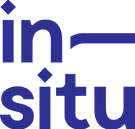
Since our early beginnings, In-Situ has been guided by a code of ethics which we wrote as a collective.
This is a set of intentions for how we work with communities, within different environments, and how we use resources.
This code guides our teamwork, our projects, our work with others and our decisions. It outlines a strong commitment and responsibility to others and to the environment.
Ethics are informed by our cultures and belief systems. They are not a firm set of rules that can be equally applied to every situation.

Human Ethics
Treat all people with respect and consideration;
Respect the rights to freedom of opinion, expression and dissent
Encourage and support mutual understanding and cooperation;
Promote an environment supportive of human dignity, bodily health and spiritual well-being;
Adopt working methods that safeguard human rights and community well-being;
Promote meaningful participation from all interested parties, encouraging active participation as equal beneficiaries;
Honor and support young people; enabling them to fulfill their essential role in creating sustainable societies for the future.

Environment Ethics
Protect the integrity of ecological systems, with special concern for biological diversity and the natural processes that sustain life;
Treat all life forms with respect and consideration, recognising that every form of life has value;
Safeguard, wherever possible, viable nature and biosphere areas, including wild brownfield land;
Leave no non-biodegradable litter in the landscape;
Actively seek ways to reduce our ecological impact in terms of energy and materials usage – reduce, reuse and recycle materials and resources;
Manage the use of renewable resources, such as water, soil and forest products, in ways that protect the health of ecosystems.
We will not work with any organisation that contributes to, or supports in any way:
Global climate change through extraction, production or distribution of fossil fuels;
The manufacture of chemicals which are persistent in the environment and linked to ecological or health concerns;
The unsustainable harvest of natural resources, including timber;
Testing on animals.

Ethical Art Practice
Operate with honesty and integrity in all our work;
Be open and transparent in our decision making;
Ensure that community expectations are not falsely raised;
Provide timely information on matters, activities and development plans that come to our attention that our local community are likely to have an interest in, or that will affect them;
Ensure our work and processes will be non-didactic;
Not undertake work that may harm people or the environment; any work create for the landscape will be produced in accordance with our environmental ethics;
Use collaborative problem solving to manage and resolve environmental or social conflicts and other disputes.
Ethical Arts Engagement
In any given project there will be participants, and people engaged through project processes;
A participant is an individual, or a collective, or an organisation, actively involved in the process of creating ‘artwork’ or generating outcomes connected to the processes undertaken. (Team members are also participants.);
A participant is different from someone who is engaged through the process of the project. People who are engaged are not involved in the pro-active processes of creating and delivering work. Once pro-actively involved, they become a participant.
Below are the ethical guiding principles for engaging both:
Participant Ethics
They will not be coerced to participate;
Their participation will always be voluntary and they may withdraw at any time;
They should understand that their views and opinions could be used as anecdotal information;
They will be acknowledged as co-creators; unless they wish to be anonymous;
If they choose to be anonymous, anonymity will be respected and guaranteed;
They will be asked to give consent for any drawings or photographs of them to be used in representing and promoting the project;
Any views and opinions gathered will be held securely and will not be available outside of the project - unless they become an integral part of the ‘artwork’ or other outcomes. (The ‘artwork’ will be created by the participants, and those participants will agree to the content of the ‘artwork’);
They should understand that the project process and ‘artwork’ may be published on the In-Situ-In-Place website and blog;
They should understand that the project process, ‘artwork’, and outcomes could be exhibited to a second audience.
Ethics For People Who Are Engaged
They should willingly engage and not be coerced in any way;
When engaged they should understand that their views and opinions could be used as anonymous anecdotal information;
Any personal information divulged during any conversation will be treated as strictly confidential, and will not be repeated, recorded, or used in any way;
Anonymity will be guaranteed, unless they choose otherwise, and give written consent to their name being used in association with the project;
Photographs, or drawings, where an individual is recognisable, will not be used in either the production or promotion of any project unless the individual gives consent.


